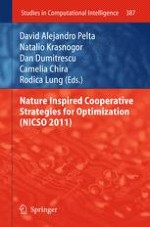Biological and other natural processes have always been a source of inspiration for computer science and information technology. Many emerging problem solving techniques integrate advanced evolution and cooperation strategies, encompassing a range of spatio-temporal scales for visionary conceptualization of evolutionary computation.
The previous editions of NICSO were held in Granada, Spain (2006), Acireale, Italy (2007), Tenerife, Spain (2008), and again in Granada in 2010. NICSO evolved to be one of the most interesting and profiled workshops in nature inspired computing.
NICSO 2011 has offered an inspiring environment for debating the state of the art ideas and techniques in nature inspired cooperative strategies and a comprehensive image on recent applications of these ideas and techniques.
The topics covered by this volume include Swarm Intelligence (such as Ant and Bee Colony Optimization), Genetic Algorithms, Multiagent Systems, Coevolution and Cooperation strategies, Adversarial Models, Synergic Building Blocks, Complex Networks, Social Impact Models, Evolutionary Design, Self Organized Criticality, Evolving Systems, Cellular Automata, Hybrid Algorithms, and Membrane Computing (P-Systems).
